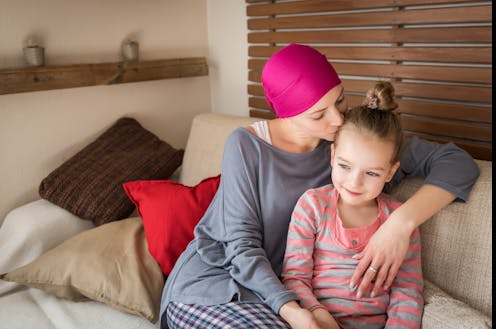If I’m diagnosed with one cancer, am I likely to get another?
- Written by Sarah Diepstraten, Senior Research Officer, Blood Cells and Blood Cancer Division, Walter and Eliza Hall Institute

Receiving a cancer diagnosis is life-changing and can cause a range of concerns about ongoing health.
Fear of cancer returning is one of the top health concerns[1]. And managing this fear[2] is an important part of cancer treatment.
But how likely is it to get cancer for a second time?
Why can cancer return?
While initial cancer treatment may seem successful, sometimes a few cancer cells remain dormant. Over time, these cancer cells can grow again and may start to cause symptoms.
This is known as cancer recurrence: when a cancer returns after a period of remission. This period could be days, months or even years. The new cancer is the same type as the original cancer, but can sometimes grow in a new location through a process called metastasis[3].
Actor Hugh Jackman has gone public about his multiple diagnoses[4] of basal cell carcinoma (a type of skin cancer) over the past decade[5].
The exact reason why cancer returns differs depending on the cancer type and the treatment received. Research[6] is ongoing[7] to identify genes associated with cancers returning. This may eventually allow doctors to tailor treatments for high-risk people.
What are the chances of cancer returning?
The risk of cancer returning differs between cancers, and between sub-types[8] of the same cancer.
New screening and treatment options have seen reductions in recurrence rates for many types of cancer. For example, between 2004 and 2019, the risk of colon cancer recurring dropped by 31-68%[9]. It is important to remember that only someone’s treatment team can assess an individual’s personal risk of cancer returning.
For most types of cancer, the highest risk of cancer returning is within the first three years[10] after entering remission. This is because any leftover cancer cells not killed by treatment are likely to start growing again sooner rather than later. Three years after entering remission, recurrence rates for most cancers decrease, meaning that every day that passes lowers the risk of the cancer returning.
Every day that passes also increases the numbers of new discoveries, and cancer drugs being developed.
What about second, unrelated cancers?
Earlier this year, we learned Sarah Ferguson, Duchess of York, had been diagnosed with malignant melanoma (a type of skin cancer) shortly after[11] being treated for breast cancer.
Although details have not been confirmed, this is likely a new cancer that isn’t a recurrence or metastasis of the first one.
Australian research from Queensland[12] and Tasmania[13] shows adults who have had cancer have around a 6-36% higher risk of developing a second primary cancer compared to the risk of cancer in the general population.
Who’s at risk of another, unrelated cancer?
With improvements in cancer diagnosis and treatment, people diagnosed with cancer are living longer than ever. This means they need to consider their long-term health, including their risk of developing another unrelated cancer.
Reasons for such cancers include[14] different types of cancers sharing the same kind of lifestyle, environmental and genetic risk factors.
The increased risk is also likely partly due to the effects that some cancer treatments and imaging procedures have on the body. However, this increased risk is relatively small[15] when compared with the (sometimes lifesaving) benefits of these treatment and procedures.
While a 6-36% greater chance of getting a second, unrelated cancer may seem large, only around 10-12% of participants developed a second cancer in the Australian studies we mentioned. Both had a median follow-up time of around five years.
Similarly, in a large US study[16] only about one in 12 adult cancer patients developed a second type of cancer in the follow-up period (an average of seven years).
The kind of first cancer you had also affects your risk of a second, unrelated cancer, as well as the type of second cancer you are at risk of. For example, in the two Australian studies we mentioned, the risk of a second cancer was greater for people with an initial diagnosis of head and neck cancer, or a haematological (blood) cancer.
People diagnosed with cancer as a child[17], adolescent or young adult[18] also have a greater risk of a second, unrelated cancer.
What can I do to lower my risk?
Regular follow-up examinations can give peace of mind, and ensure any subsequent cancer is caught early, when there’s the best chance of successful treatment.
Maintenance therapy[19] may be used to reduce the risk of some types of cancer returning. However, despite ongoing research[20], there are no specific treatments against cancer recurrence or developing a second, unrelated cancer.
But there are things you can do to help lower your general risk of cancer – not smoking, being physically active, eating well, maintaining a healthy body weight, limiting alcohol intake and being sun safe. These all reduce the chance of cancer returning[21] and getting a second cancer[22].
References
- ^ top health concerns (www.ncbi.nlm.nih.gov)
- ^ managing this fear (www.cancercouncil.com.au)
- ^ metastasis (theconversation.com)
- ^ multiple diagnoses (www.skincancer.org)
- ^ past decade (www.bbc.com)
- ^ Research (www.ncbi.nlm.nih.gov)
- ^ ongoing (onlinelibrary.wiley.com)
- ^ sub-types (www.ncbi.nlm.nih.gov)
- ^ 31-68% (jamanetwork.com)
- ^ first three years (pubmed.ncbi.nlm.nih.gov)
- ^ shortly after (www.bbc.com)
- ^ Queensland (bmccancer.biomedcentral.com)
- ^ Tasmania (acsjournals.onlinelibrary.wiley.com)
- ^ include (www.cancer.net)
- ^ relatively small (www.ncbi.nlm.nih.gov)
- ^ large US study (acsjournals.onlinelibrary.wiley.com)
- ^ child (www.mja.com.au)
- ^ adolescent or young adult (www.liebertpub.com)
- ^ Maintenance therapy (www.lymphoma.org.au)
- ^ research (febs.onlinelibrary.wiley.com)
- ^ cancer returning (acsjournals.onlinelibrary.wiley.com)
- ^ getting a second cancer (www.cancer.net)
Read more https://theconversation.com/if-im-diagnosed-with-one-cancer-am-i-likely-to-get-another-226386

















